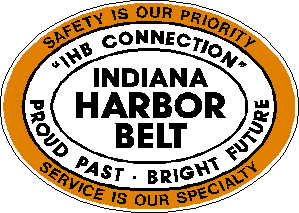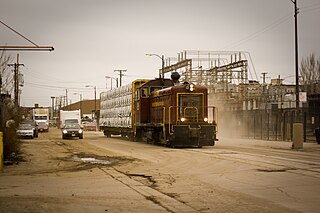
The Grand Trunk Railway was a railway system that operated in the Canadian provinces of Quebec and Ontario and in the American states of Connecticut, Maine, Michigan, Massachusetts, New Hampshire, and Vermont. The railway was operated from headquarters in Montreal, Quebec, with corporate headquarters in London, United Kingdom. It cost an estimated $160 million to build. The Grand Trunk, its subsidiaries, and the Canadian Government Railways were precursors of today's Canadian National Railway.

Dearborn Station was, beginning in the late 1800s, one of six intercity train stations serving downtown Chicago, Illinois. It remained in operation until May 1, 1971. Built in 1883, it is located at Dearborn and Polk Streets, adjacent to Printers Row. The station was owned by the Chicago & Western Indiana Railroad, which itself was owned by the companies operating over its line. The station is now a shopping mall housing office, retail, and entertainment spaces.
The Lake Shore and Michigan Southern Railway, established in 1833 and sometimes referred to as the Lake Shore, was a major part of the New York Central Railroad's Water Level Route from Buffalo, New York, to Chicago, Illinois, primarily along the south shore of Lake Erie and across northern Indiana. The line's trackage remains a major rail transportation corridor used by Amtrak passenger trains and several freight lines; in 1998, its ownership was split at Cleveland between CSX to the east and Norfolk Southern in the west.

The Grand Trunk Western Railroad Company is an American subsidiary of the Canadian National Railway operating in Michigan, Illinois, Indiana, and Ohio. Since a corporate restructuring in 1971, the railroad has been under CN's subsidiary holding company, the Grand Trunk Corporation. Grand Trunk Western's routes are part of CN's Michigan Division. Its primary mainline between Chicago and Port Huron, Michigan serves as a connection between railroad interchanges in Chicago and rail lines in eastern Canada and the Northeastern United States. The railroad's extensive trackage in Detroit and across southern Michigan has made it an essential link for the automotive industry as a hauler of parts and automobiles from manufacturing plants.

Brighton Park is a community area located on the southwest side of Chicago, Illinois. It is number 58 of the 77 community areas of Chicago.

The Duluth, Winnipeg and Pacific Railway is a subsidiary railroad of Canadian National Railway (CN) operating in northern Minnesota, United States. A CN system-wide rebranding beginning in 1995 has seen the DWP logo and name largely replaced by its parent company. The DWP line is CN's connection between International Falls and Duluth, Minnesota, where the railroad connects to a short stretch of the former Duluth, Missabe and Iron Range Railway before following the former Wisconsin Central to Chicago, Illinois.

The Indiana Harbor Belt Railroad is a Class III railroad in the United States.

The Chicago North Shore and Milwaukee Railroad, also known as the North Shore Line, was an interurban railroad that operated passenger and freight service over an 88.9-mile (143.1 km) route between the Chicago Loop and downtown Milwaukee, as well as an 8.6-mile (13.8 km) branch line between the villages of Lake Bluff and Mundelein, Illinois. The North Shore Line also provided streetcar, city bus and motor coach services along its interurban route.

The Pittsburgh, Cincinnati, Chicago and St. Louis Railroad, commonly called the Pan Handle Route, was a railroad that was part of the Pennsylvania Railroad system. Its common name came from its main line, which began at Pittsburgh, Pennsylvania, crossed the Northern Panhandle of West Virginia, and continued west to Bradford, Ohio, where it split into a northern line to Chicago and a southern one through Indianapolis, Indiana, to East St. Louis, Illinois.

The Chicago and Western Indiana Railroad was the owner of Dearborn Station in Chicago and the trackage leading to it. It was owned equally by five of the railroads using it to reach the terminal, and kept those companies from needing their own lines into the city. With the closure of Dearborn Station in 1971 and the Calumet steel mills in 1985, the railroad was gradually downgraded until 1994 when it became a subsidiary of the Union Pacific Corporation.

The Terminal Railroad Association of St. Louis is a Class III switching and terminal railroad that handles traffic in the St. Louis, Missouri, metropolitan area. It is co-owned by five of the six Class I railroads that reach the city.
The Gateway Eastern Railway is a railroad subsidiary of the Kansas City Southern Railway (KCS), owning a 17-mile (27 km) main line between East Alton and East St. Louis, Illinois, United States. Originally created in 1994 as a subsidiary of the Gateway Western Railway, which acquired the East St. Louis-Kansas City line of the Chicago, Missouri and Western Railway in 1990, it was acquired by KCS along with its parent in 1997.

The Chicago Terminal Railroad was a switching and terminal railroad that operated over former Milwaukee Road/Canadian Pacific and Chicago and North Western/Union Pacific trackage in northern Illinois. The railroad began its operations on January 2, 2007. The railroad rostered a total of three locomotive units, all of EMD design.
The Chicago and Southern Railroad built a rail line in northeastern Illinois, extending south from Chicago to Thornton. It now mainly forms part of the Grand Trunk Western Railroad, while the north end has been operated by the Atchison, Topeka and Santa Fe Railway, the Illinois Northern Railway, and most recently the Central Illinois Railroad.

The Chicago Junction Railway operated a switching and terminal railroad in Chicago, connecting the Union Stock Yards with most other railroads in the city. It also briefly operated an outer belt, which became the Indiana Harbor Belt Railroad in 1907. The New York Central Railroad acquired control of the company in 1922 and leased it to subsidiary Chicago River and Indiana Railroad. The line is now owned and operated by the Norfolk Southern Railway.

The Kenwood branch was a rapid transit line which was part of the Chicago 'L' system from 1907 to 1957. The branch served the Kenwood neighborhood of Chicago and consisted of six elevated stations. It opened on September 20, 1907 and closed on December 1, 1957.

The Wabash Railroad was a Class I railroad that operated in the mid-central United States. It served a large area, including track in the states of Ohio, Indiana, Illinois, Iowa, Michigan, and Missouri and the province of Ontario. Its primary connections included Chicago, Illinois; Kansas City, Missouri; Detroit, Michigan; Buffalo, New York; St. Louis, Missouri; and Toledo, Ohio.

The Vandalia Railroad Company was incorporated January 1, 1905, by a merger of several lines in Indiana and Illinois that formed a 471-mile railroad consisting of lines mostly west of Indianapolis.

The Illinois Northern Railroad was an industrial switching railroad serving Chicago's southwest side. From their yard at 26th St. and Western Ave. the line went southwest to the Santa Fe Railway's Corwith Yard, connecting with most major area railroads and serving on-line customers on the way. They also leased and switched track east of their yard. Incorporated in 1901, it was merged into the Santa Fe Railway in 1975.
















